- About
- Visiting
- What’s On
- Venue hire
- Catalogues
- Collections
- 101 Treasures of Chetham’s
- Digital Resources
- The Flowers of Histories
- A Book of Hours from France
- The Manchester Scrapbook
- Thomas Barritt of Manchester
- Art Treasures Examiner of 1857
- Manchester Association for Constitutional Order
- The North Western Museum of Science and Industry: Some Reminiscences by Richard Hills
- Criminal Manchester
- The Cup of Destiny
- Athenaeum Souvenir
- Middle English Manuscripts
- Manchester and Liverpool of Today
- Hollingworth’s Mancuniensis
- Memoir of Cecil Wray
- William Seward’s Diary
- The Anti-Monopolist
- Fishwick’s History of Rochdale
- Knyvett’s Defence of this Realm
- Tractatus de Nigromantia
- Axon Ballads
- Printed Books & Ephemera
- Archives & Manuscripts
- Prints and Photographs
- Blog
- Support us
Accidental heroes – getting in on the act
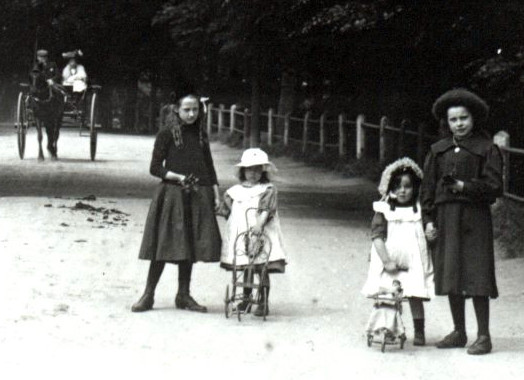
We’re in the midst of the digital portion of one of our current projects, putting swathes of material from our Salford and district collections online. With the help and support of the Booth Charities, one of Salford’s oldest philanthropic organisations, we’ve got a a completely new database running for our archival and manuscript collections, and our Salford collections will star. We’ll be blogging about various aspects of the collections as they go online, and when you search the catalogue in the future you’ll be calling on increasingly large resources.
Today we’ll take a new angle on one of the largest collections of photographs of the Salford area, created and collected by Frank and Elsie Mullineux over many years as they documented the changes of the post-war era with their own cameras, and assembled many older pictures, texts, postcards and other memorabilia of older generations. The collection is justly celebrated, and you’ll probably have seen at least some of their material online – with our new system we’ll be providing full and systematic access to it, and to other collections we’ll come back to in future posts.
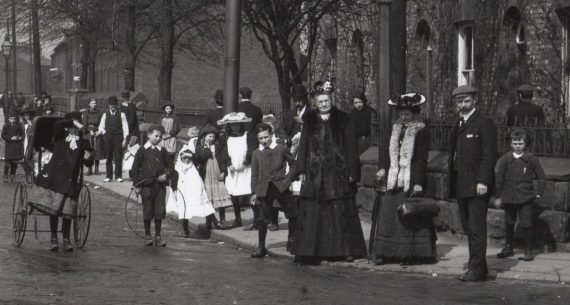
A small crowd gathers in a corner of the shot to watch the photographer as he photographs the tram lines and street at Winton
The Mullineuxs organised their collection by place – Eccles, Worsley, Little Hulton etc. – and by theme – Transport, Chapels, Industries. There are plenty of portrait and posed group photos, but today we’ll look at small crops from much larger images to capture the ‘accidental’ inclusions of people in shot, like the one above from Winton, somewhere around 1900.

Only a tiny area of a shot of ‘the rocks’ at Worsley, but this gent seems pleased
The early photos they collected were necessarily taken with large plate cameras on a tripod, and when spotted the photographer always seems to have attracted the interest of adults and children alike. Some seem to go into ‘pose’ mode, others can look as if they are studying to appear nonchalant.
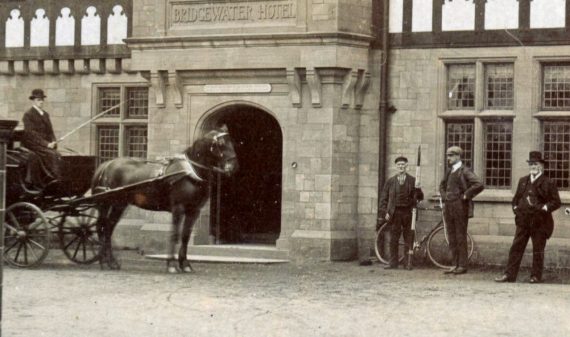
Some late Victorian(?) gents looking a little stiff in a corner of a shot of the then-new Bridgewater Hotel at Worsley
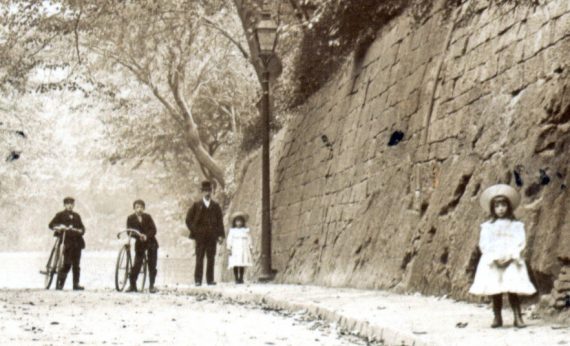
Back to ‘the rocks’, Worsley, and two very proud young cyclists want to be seen in this crop. The girl on the right seems to be unsure about getting nearer
Perhaps some suspected they would be playing a bit part for years to come in a commercial postcard for people to send news of the weather, wishes for good health, or used the picture itself as directions for visitors:

Young man looking very dapper in this detail from a postcard of Greenleach Lane, Worsley.
In the shot above, the smartly-dressed boy in the new collar and shoes (it must be Sunday) is a fraction of the frame, casual though he’s clearly decided to be. The writer of the card wanted the whole shot to help with routefinding, though: ‘You come up this lane from Worsley Station to our house, it is a straight road over Roe Green, about 20 minutes walk towards Walkden. The railway line to Bolton is on the left of the P.C.’
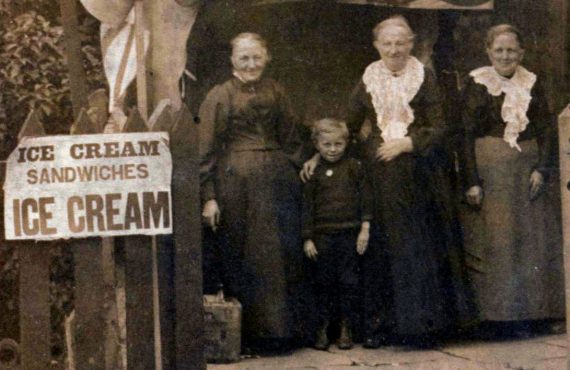
This little group are central to a postcard commemorating the festivities for the coronation of George V, and evidently conscious of the honour.
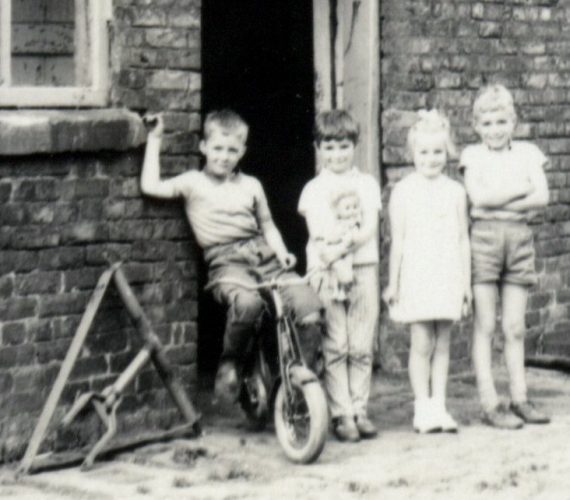
Children keen to be in one of the Mullineuxs’ shots documenting the changes created by the M62. The theme of the shot is some farm stables, but it’s the doll and the bike for the kids
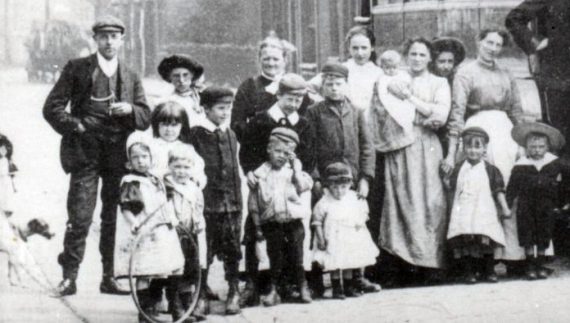
At the edge of shot in a photo commemorating the first electric tram through to Worsley, everyone wants to be in, even the dog on the left. And ‘look at my hoop!’
If the camera was further off, however, and as time passed and snapshot cameras became smaller and less obtrusive, a lot less self-conscious behaviour got captured by the lens. Those documenting buildings and large scenes seem to have avoided getting people in shot as much as possible, rather to our frustration now as we would all like to see how a street-scene 100 years ago really looked. But sometimes people got in there; the next two crops are from the same shot, with everyone going about their business.
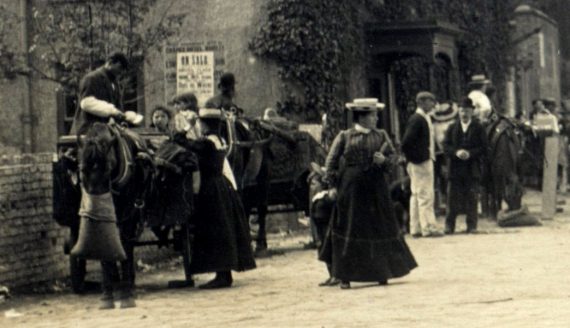
From an 1890s shot of Barton Road, Worsley – ice cream being served from the cart, and even the horse gets a nose-bag

The other side of the street, with a family out in the pony and trap and straw hats for summer
The railway stations, trains and tram stops that drew the photographers who provided the material for the Mullineuxs’ transport collections probably never found their subjects devoid of people in daylight. They may be incidental to the main theme, but they draw us in now – where had they come from? What did they do next? Can you tell a person’s social class from their hat?

Buying newspapers outside Eccles Station in this crop
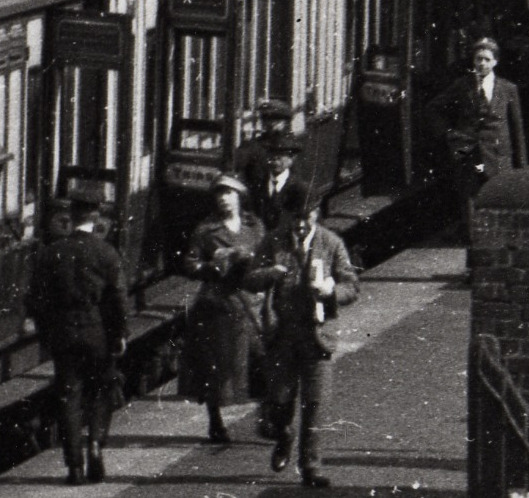
Passengers pour off the third-class carriages in Walkden – early 1920s?
We don’t know if Frank or Elsie waited for the ladies below to move out of shot in order to get a clean photo of the factory chimney that was the focus. But if we stay with the conversation in the corner, it looks as if the gossip could continue for a while.
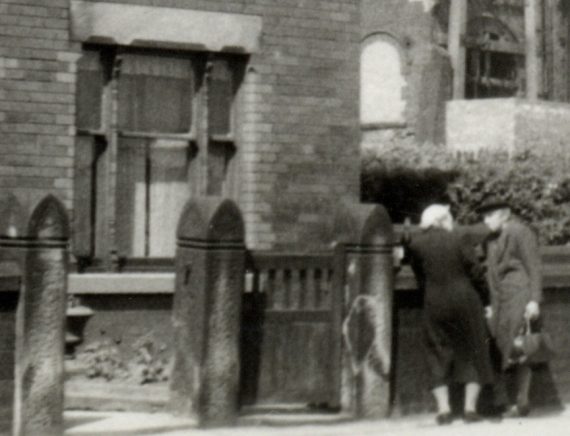
Incidental in a corner of a shot of factory chimney, two elderly ladies chat in 1952
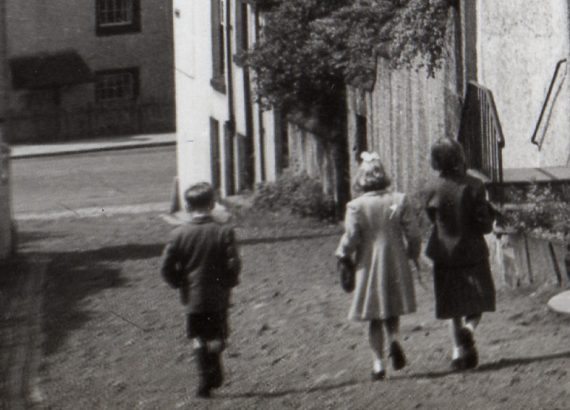
On their way to the main road, these three small friends leave the shot as a forgotten detail
There will be plenty more blogs from this project, so feel free to let us know what your favourite themes are. Meanwhile, have any pictures of Salford life you’d like to share as part of this project, or items you’d like to add to our collections? Have you, or would you like to write anything about growing up, working, or living there? See anything you recognise when you search the collections? Please let us know, either comment below or drop us a line by phone or email.

5 Comments
Howard Temperley
Wonderful to see……My roots are in Roe Green and Worsley.
ferguswilde
Thanks, Howard – we’ll be putting plenty more up, but there are already quite a few Roe Green and Worsley pics on the database. For Roe Green, it’s mainly railway pics at the moment. The Mullineuxs seem to have been given photos by Frank Howell, who was evidently keen to get down by the trackside with his camera in the ’50s. For Worsley, though, there’s already quite a bit of visual material. If you’d like to go to our catalogue homepage at http://library.chethams.com/catalogues/archives-and-manuscripts/, click the link and enter ‘Roe Green’ or ‘Worsley’ in the ‘Quick Search’ box, you should find something of interest. There are lots of archival records, but if you scroll down there are lots of photos too.
Tony Lee
I am interested in receiving old photographs of Worsley and Roe Green. Many thanks
Tony Lee
ferguswilde
Thanks, Tony – you can see a great many such photos using the searches I’ve mentioned above in my reply to Howard, and you’re welcome to download those. If any reade has any other pics they can offer to Tony, do let us know here!
Christine Robins
I used to live on Worsley Rd. It’s fantastic to see all these old photos so many thanks